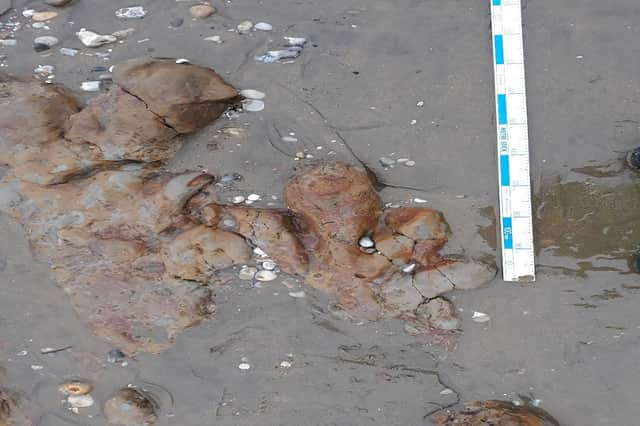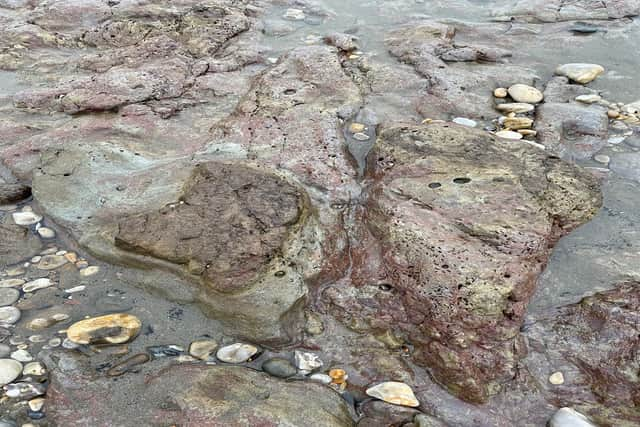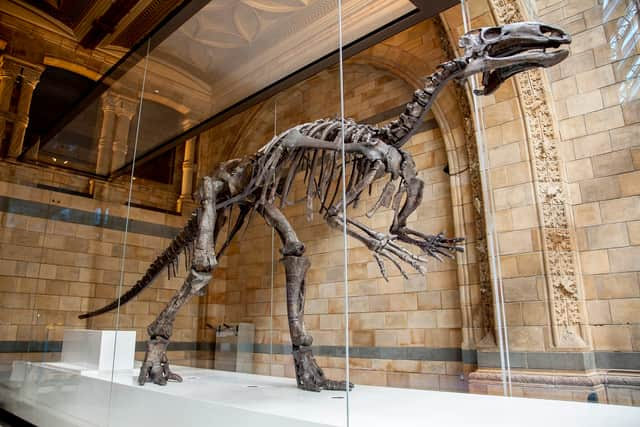Dinosaur footprints uncovered on Isle of Wight that could belong to animal twice as long as average car


It what feels like an episode of The Flinstones or a Jurassic Park film coming to life, engineers working on the Isle of Wight were left in surprise as they uncovered footprints during ground investigations.
A team from the Enivronment Agency and JBA Consulting were working to hold the tide back at the Yaverland seafront when the dramatic discovery was made. Large fossils dating back 125 million years were found during investigations that form part of plans to bolster sea defences.
Advertisement
Hide AdAdvertisement
Hide AdExperts believe the remains could be from a mantellisaurus, seven metres long with three toes on each foot, which made them stand out from other dinosaurs.
The fossils were previously hidden, but excavation exposed them alongside everyday life – a beachside café, a car park and a bus stop. Holidaymakers in the area would have been blissfully unaware – and maybe alarmed at the thought – of who, or what, was there long before them.


Nick Gray, the Environment Agency’s flood and coastal-risk manager for the Solent and South Downs area, said: “Dinosaurs existing right where our team is working brings old and new together – the modern challenges of combatting climate change with a period of time we can only imagine.
“We’ve all read the stories and seen the films, but this gives us just a hint of what life was like.“Reducing coastal flood and erosion risk to island people, property and infrastructure is a priority for the Environment Agency, but we’ll continue to have more dinosaur discoveries in mind.”
Advertisement
Hide AdAdvertisement
Hide AdThe Environment Agency brought in JBA Consulting to manage the flood-protection project, and a team from the local Dinosaur Isle Museum was on hand after several similar markings were found locally in recent years.
Dr Martin Munt, curator of the Dinosaur Isle Museum, at Sandown, said: “The Isle of Wight is the richest dinosaur location in Europe, but this is still a wonderful find. We have located 35 different types, and the area was once also heavy with plants, crocodiles, pterosaurs, amphibians, fish and invertebrates like insects and freshwater mussels.


“We cannot be totally sure about a print’s identity, but the three-toed feet makes it likely a mantellisaurus was here, not just in other parts of the south coast where they were more common – or that’s what we thought until now.”
The mantellisaurus hit the scales at a whopping 750 kilograms, but not the biggest dinosaur by any means. And unlike other breeds, they got about on their hind legs like an ostrich but probably not as quickly, only on all-fours when standing still or moving slowly.
Advertisement
Hide AdAdvertisement
Hide AdA fully-grown mantellisaurus would have been almost twice the length of an average car, marching a slow thunder with huge strides that have clearly left their mark on time.
What we now call the Isle of Wight was the perfect habitat for dinosaurs, generating a diverse collection of bones and fossils over millennia, an impressive roll-call for scientists to explore.
Stuart Noon, heritage lead for JBA Consulting, added: “This represents a hugely important and significant discovery for the project, as finding the new footprints makes it clear that the land on which the dinosaurs walked is likely to stretch the whole length of Yaverland beach.”
The latest capture cements the Isle of Wight as Britain’s dinosaur capital. The reptile-revealing rocks are known as the Wessex Formation, a magnet for geologists and palaeontologists.
Advertisement
Hide AdAdvertisement
Hide AdMoreover, the engineers who helped uncover the footprints were on site to work up plans for improved flood defences for more than 600 properties in Shanklin and Yaverland, a project seeing collaboration between the Environment Agency and Isle of Wight Council.
An online consultation and six public events starting this week are being held to seek the views of local people on the options available for flood-protection.
Comment Guidelines
National World encourages reader discussion on our stories. User feedback, insights and back-and-forth exchanges add a rich layer of context to reporting. Please review our Community Guidelines before commenting.
